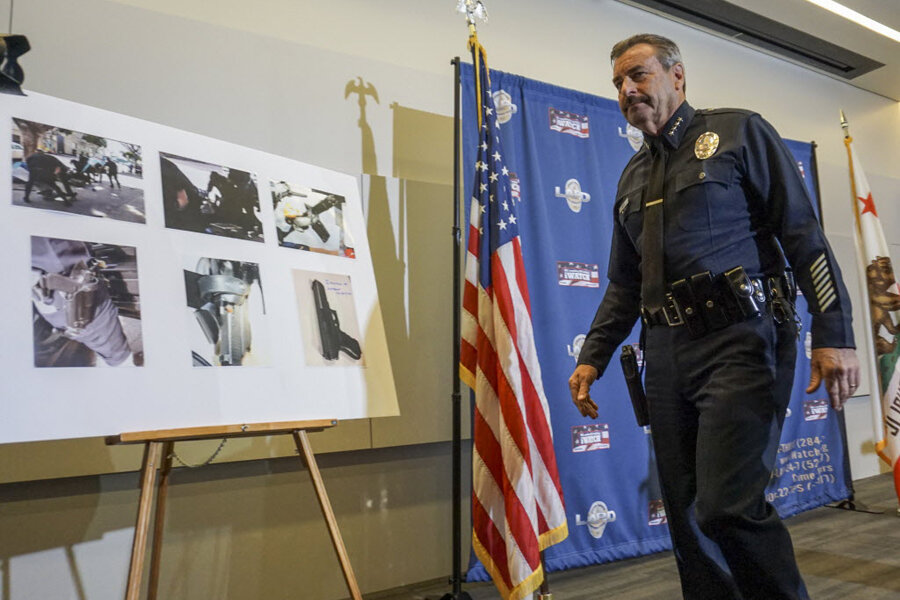LAPD shooting reignites debate: Are police body cameras effective?
Loading...
| Los Angeles
The shooting death of a homeless man on Skid Row by Los Angeles police is reigniting a heated debate about the strengths and weaknesses of police body cameras.
Sunday's incident was captured on at least one body cam worn by a police officer. Police have not yet said what that footage shows, and it is not clear if that video will be made public. But another video captured by a bystander has been making the rounds on the Internet and already has sparked considerable public outrage.
Los Angeles is one of the US municipalities trying to use body cameras in community policing, particularly since several controversial police incidents last year. In December, L.A. Mayor Eric Garcetti announced that LAPD officers would be outfitted with a total of 7,000 body cameras in an effort to improve transparency in policing. Now, less than three months later, footage from such cameras is likely to become central in what is already becoming a high-profile police shooting case.
“This case will be analyzed and reanalyzed for what it says about the pluses and minuses of crime-scene videos, whether more police departments will want to invest in them,” says Lance LoRusso, a former law enforcement officer who is author of the book, “When Cops Kill.”
The bystander video from Sunday in Los Angeles shows four officers engaged in a chaotic struggle, wrestling the man to the ground, after the words “drop the gun!” are heard and repeated. Police had been dispatched to the downtown homeless encampment on a robbery call. Witnesses said the man, who was pronounced dead at a hospital, had been fighting with someone inside his tent.
Body cameras have been a topic of heated debate since police-involved deaths last year in Ferguson, Mo., and New York, which sparked protests against police violence in communities around the country.
Widely conflicting accounts of the August shooting of Michael Brown in Ferguson prompted some supporters of body cameras to push for their implementation so that a video record of controversial incidents is available. Officers in Ferguson have since been outfitted with body cameras.
However, what can be seen in such videos may not necessarily mesh with what is eventually decided in the judicial system, analysts say.
In the case of Eric Garner in New York, a bystander's cellphone video showed the man's death at the hands of a New York police officer. But a grand jury, which heard the officer’s account of the incident, declined to press charges against him.
“Consider the many images showing black men who are beaten or lose their lives at the hands of police officers: from Rodney King through Eric Garner to this incident” in Los Angeles, says Gordon Coonfield, a Villanova communication professor who studies the interrelation of technology and visual imagery in contemporary culture.
Just because these videos can be evidence in the courtroom does not mean they will be given the same weight as less visible evidence, says Professor Coonfield, who made his comments via e-mail.
“That invisible evidence – officers’ testimony – tells a story that gives the images a different meaning, one that has been persuasive to jurors and judges, if not to the public,” he says.
Proponents of body cams argue that the technology can decrease the likelihood of unprofessional conduct by police and can help officers defend themselves against unwarranted or frivolous accusations of brutality.
However, critics are concerned about privacy invasions if the cameras are used inappropriately. Also, some argue that people may be less inclined to summon the police in situations that would otherwise call for law enforcement involvement because, for whatever reason, they do not want to be filmed.
“We are still in the early stages of documenting empirically the potential benefits and costs (including privacy, emotional, and financial costs) associated with the use of body cams by police,” says Frederic Reamer, professor in the School of Social Work at Rhode Island College in Providence, in an e-mail.
He notes a study done in Rialto, Calif., which is being cited by other police forces for why they are incorporating the cameras. Complaints against Rialto police fell 90 percent during the study period, and findings showed that officers’ use of body cameras reduced the use of force by roughly 50 percent.
“The researchers found that police were nearly twice as likely to use force in the control condition, without cameras, as in the treatment condition, with cameras,” Professor Reamer writes.
Another incident where video has become important – in this case, non-police video – was the police shooting of 12-year-old Tamir Rice in Cleveland last year. Tamir was playing with a toy gun. Footage from the surveillance camera showed just how quickly the incident unfolded once officers arrived on the scene.
“Anytime there's a situation where authorities or civilians question the timing, sequence or events of a police altercation, you're going to have those who argue that these questions could very easily be answered if captured on video,” says Michael Worgul, managing partner of the Worgul Law Firm in Pittsburgh, who has extensive experience with use of video in courtrooms. “No surprise here: That's exactly what we've seen with this LAPD incident,” says Mr. Worgul, who made his comments via e-mail.







